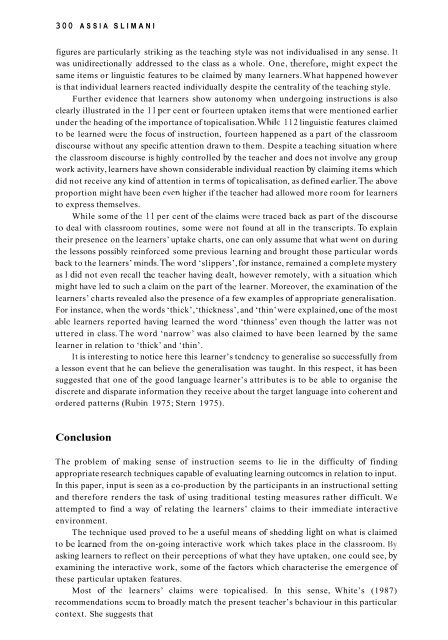English Language Teaching in its Social Context
English Language Teaching in its Social Context
English Language Teaching in its Social Context
You also want an ePaper? Increase the reach of your titles
YUMPU automatically turns print PDFs into web optimized ePapers that Google loves.
300 ASSIA SLIMANIfigures are particularly strik<strong>in</strong>g as the teach<strong>in</strong>g style was not <strong>in</strong>dividualised <strong>in</strong> any sense. Itwas unidirectionally addressed to the class as a whole. One, therefore, might expect thesame items or l<strong>in</strong>guistic features to be claimed by many learners. What happened howeveris that <strong>in</strong>dividual learners reacted <strong>in</strong>dividually despite the centrality of the teach<strong>in</strong>g style.Further evidence that learners show autonomy when undergo<strong>in</strong>g <strong>in</strong>structions is alsoclearly illustrated <strong>in</strong> the 1 1 per cent or fourteen uptaken items that were mentioned earlierunder the head<strong>in</strong>g of the importance of topicalisation. While 1 12 l<strong>in</strong>guistic features claimedto be learned were the focus of <strong>in</strong>struction, fourteen happened as a part of the classroomdiscourse without any specific attention drawn to them. Despite a teach<strong>in</strong>g situation wherethe classroom discourse is highly controlled by the teacher and does not <strong>in</strong>volve any groupwork activity, learners have shown considerable <strong>in</strong>dividual reaction by claim<strong>in</strong>g items whichdid not receive any k<strong>in</strong>d of attention <strong>in</strong> terms of topicalisation, as def<strong>in</strong>ed earlier.The aboveproportion might have been even higher if the teacher had allowed more room for learnersto express themselves.While some of the 1 1 per cent of the claims were traced back as part of the discourseto deal with classroom rout<strong>in</strong>es, some were not found at all <strong>in</strong> the transcripts. To expla<strong>in</strong>their presence on the learners’ uptake charts, one can only assume that what went on dur<strong>in</strong>gthe lessons possibly re<strong>in</strong>forced some previous learn<strong>in</strong>g and brought those particular wordsback to the learners’ m<strong>in</strong>ds.The word ‘slippers’, for <strong>in</strong>stance, rema<strong>in</strong>ed a complete mysteryas I did not even recall the teacher hav<strong>in</strong>g dealt, however remotely, with a situation whichmight have led to such a claim on the part of the learner. Moreover, the exam<strong>in</strong>ation of thelearners’ charts revealed also the presence of a few examples of appropriate generalisation.For <strong>in</strong>stance, when the words ‘thick’, ‘thickness’, and ‘th<strong>in</strong>’ were expla<strong>in</strong>ed, one of the mostable learners reported hav<strong>in</strong>g learned the word ‘th<strong>in</strong>ness’ even though the latter was notuttered <strong>in</strong> class. The word ‘narrow’ was also claimed to have been learned by the samelearner <strong>in</strong> relation to ‘thick’ and ‘th<strong>in</strong>’.It is <strong>in</strong>terest<strong>in</strong>g to notice here this learner’s tcndcncy to generalise so successfully froma lesson event that he can believe the generalisation was taught. In this respect, it has beensuggested that one of the good language learner’s attributes is to be able to organise thediscrete and disparate <strong>in</strong>formation they receive about the target language <strong>in</strong>to coherent andordered patterns (Rub<strong>in</strong> 1975; Stern 1975).ConclusionThe problem of mak<strong>in</strong>g sense of <strong>in</strong>struction seems to lie <strong>in</strong> the difficulty of f<strong>in</strong>d<strong>in</strong>gappropriate research techniques capable of evaluat<strong>in</strong>g learn<strong>in</strong>g outcomes <strong>in</strong> relation to <strong>in</strong>put.In this paper, <strong>in</strong>put is seen as a co-production by the participants <strong>in</strong> an <strong>in</strong>structional sett<strong>in</strong>gand therefore renders the task of us<strong>in</strong>g traditional test<strong>in</strong>g measures rather difficult. Weattempted to f<strong>in</strong>d a way of relat<strong>in</strong>g the learners’ claims to their immediate <strong>in</strong>teractiveenvironment.The technique used proved to lie a useful means of shedd<strong>in</strong>g light on what is claimedto be lcarncd from the on-go<strong>in</strong>g <strong>in</strong>teractive work which takes place <strong>in</strong> the classroom. Byask<strong>in</strong>g learners to reflect on their perceptions of what they have uptaken, one could see, byexam<strong>in</strong><strong>in</strong>g the <strong>in</strong>teractive work, some of the factors which characterise the emergence ofthese particular uptaken features.Most of the learners’ claims were topicalised. In this sense, White’s (1987)recommendations seem to broadly match the present teacher’s bchaviour <strong>in</strong> this particularcontext. She suggests that












